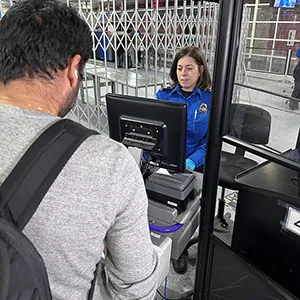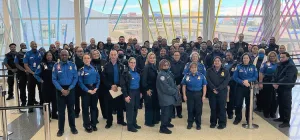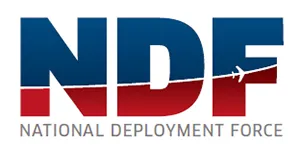 Volunteers for the National Deployment Force support security operations in Alaska. (TSA photo)
Volunteers for the National Deployment Force support security operations in Alaska. (TSA photo)
Summer travel is sizzling, and hundreds of TSA officers are volunteering to temporarily leave home to help their peers at other airports across the country.
As TSA screens a record number of travelers during the warm weather season, the agency’s National Deployment Office is busy making sure all of our checkpoints have the personnel they need.
On July 7, TSA, for the first time ever, screened more than 3 million passengers in a single day, and in late June screened the most travelers in a single week – 19.5 million.
“We have about 690 active national deployment officers (NDOs) at the moment, and our current forecasts have a peak deployment of about 450 to 460 officers across 57 airports,” said Alex McAuliffe, TSA’s director of Specialized Programs and Deployment. “We also are supporting a number of National Special Security Events this summer including the 2024 NATO Summit in Washington, D.C., the Republican and Democratic National Conventions, and the United Nations General Assembly. During those events, we may exceed 500 deployed officers.”
McAuliffe said the majority of NDO support is at understaffed airports where the cost of living is high, housing is limited and recruiting populations are small.
He said like passenger volumes, deployments are up for the summer, but compared to the last two summer seasons, the number of officers deployed is actually down.
“It is directly related to the passing of TSA’s pay plan,” McAuliffe explained. “We had record deployment levels in fiscal years 2022 and 2023, and a good deal of that was related to hiring and retention challenges. The new pay plan that went into effect in July 2023 has allowed many airports to improve and/or resolve their staffing challenges, thereby reducing the need for NDOs.”
However, he said with the historic travel volumes this summer, the NDO program is ready to increase deployments if needed.
Ins and outs of NDO service
Typically, officers who volunteer to be deployed to other airports as part of the NDO program serve for at least a year, up to three months at single locations, although deployments can sometimes be longer or shorter.
“Officer selection for deployment is based on operational needs and the specific requirements of the requesting airport,” explained George Dechon, National Deployment Office area coordinator. “Other factors, such as officer availability and specific certifications needed to operate equipment and processes at the deployment location are also considered. As much as possible, officers and teams are selected so they fit seamlessly with and complement existing airport operations.”
Dechon said officers who volunteer to serve in the National Deployment Force (NDF) have additional training and the flexibility to deploy on short notice, and they do so with great pride and commitment to the agency’s mission.
“We have an entire team that stands behind every officer, helping to support them both while deployed and at home,” he said. “Once support requests are approved, an NDF Operations team, a finance team, a training team, area coordinators, deployment team leads and more all work together to efficiently organize, support, sustain and then, when it’s time, demobilize officers and the resources needed for each deployment.”
Dechon said lodging, transportation, parking, site-specific orientation, training, briefings, badging, meticulous expense tracking, travel vouchering and more are just some of the needs commonly addressed.
“We even maintain a 24/7 emergency line to assure support resources are available for our officers around the clock,” added Dechon. “It doesn’t stop there. This same cohesive team also works to ensure that the NDF program and its officers remain ready at all times for the next deployment.”
Before taking their first steps with the NDF program, new officers participate in a comprehensive, immersive orientation. McAuliffe said the four-day new recruit orientation helps them learn about the demands of being on the road and provides instruction on the various requirements.
“The orientation process is also an opportunity to share advice, tips, tools and tricks from more experienced NDF officers to help make deployments and various processes easier,” McAuliffe noted. “As they venture out for the first time, new recruits are also assigned mentors to help them navigate NDF-specific tasks and hardwire best practices.”
What about the incentives?
McAuliffe said two of the most expensive deployment locations are Jackson Hole, Wyoming, and Key West, Florida, due to the high cost of living and limited housing. TSA is offering special pay incentives for officers willing to work in those areas full- or part-time, and McAuliffe said “finding the right pay/incentive will be cheaper for the agency than providing continuous NDO support.”
McAuliffe said TSA offers some great benefits to officers who join the NDO program.
“NDO has our own awards budget and Model Officer Program to recognize the outstanding work our officers do in the field,” he said. “NDO covers all travel costs and provides a per diem to cover meals and incidental costs. Deploying to airports across the country exposes them to a broad range of operations from a large to small airport, offering a different pace of work, operational requirements and management styles.”
McAuliffe describes the NDO program as a “phenomenal opportunity” for employees.
“You have the opportunity to travel to other parts of the country, grow your skillset as an officer, and my favorite thing about the program is we are out there helping airports and our fellow TSA officers when they need support.”
By Don Wagner, TSA Strategic Communications & Public Affairs



